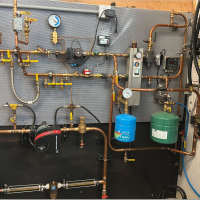Best Of
Re: What was the best MacGuyver moment you actually saw on a job site?
I run two fire tube boilers and have a box of tapered wooden plugs for just that reason. Haven't had to use them yet
 Grallert
Grallert
Re: Replacing iron pipe / Non-filling radiator
An example of what happens to dynamic pressure ( pump spinning) in a system with either low fill, or a circ develop in high pressure differential.
So in some cases the upper portion of the system could be running at negative pressure. The second slide shows a system with low fill pressure 5 static, notice - pressure starting just past 1/2 way around the loop.
These are just examples, you would plot your exact piping path to determine where you could go sub-atmospheric. Or gauge a few locations.
Any auto air vents at that location would allow air in, instead of out!
A gauge at that highest radiator should read at less 5 psi static. And ideally not drop, maybe increase when the circ runs. Pumping Away allows that to happen.
 hot_rod
hot_rod
Re: Broken anode rod?
Hi, Did they ever get the water tested? It's a band-aid, but you could add a float vent to the hot outlet of the heater. You would want to make a trap in the pipe so any air/gas was trapped at the vent. If you wanted to play scientist, you could collect this air from a faucet with a plastic bag, and then hold a match to the bag. If it only burns a hole in the bag, it's air. Is the contents of the bag burn, it's gas from the action of the anode. I've done this… it doesn't blow up or anything so exciting. 🤠 That test would help you to know where the "air" is coming from.
Yours, Larry
Re: Boiler Header Manifold
We used BASCO on Long Island in the 1980s & 1990s…Excellent & reasonable. Haven't seen them in years. The biggest issue I've seen with the cheap imports is not the welds, but the branches not being 100% plumb with eachother…skewed....Mad Dog
Re: Boiler Header Manifold
I've used them several times with good results. With that said, be very careful with that company. I used to spend tens of thousands per year there and while they were usually okay, the instances where they'd ship the wrong item or skip something in the order was like pulling teeth to get a resolution. Customer service is beyond horrible and the supervisor is downright insane- always blaming the customers for the company's faults. We're currently involved in a legal battle where they took payment for a several thousand dollar order and never sent it out.
Re: What are the most well-established US manufacturers of residential electric boilers
This issue has ideas and calculations for operating high temperature legacy systems at lower temperatures. To allow for condensing boilers or heat pumps.
 hot_rod
hot_rod
Re: What are the most well-established US manufacturers of residential electric boilers
Your 600 gallons burned in a 75% boiler is about 660 therms of heat.
That works out to $3200 with resistance heat and about 1/3 of that so about $1000 with a heat pump.
Your load is pretty low, around 30000btu, so well within the range of cold climate heat pumps. It is also low enough that a 100A service will still work as long as you don't have an EV.
Smart money is to replace the AC unit with a heat pump and replace the boiler with a small resistance boiler (say 7kW) to supplement the heat pump and even out the temps where you don't have ducting.
You could go all resistance boiler and no heat pump, but the operating cost will be pretty high. This option would make sense if you are doing some major winterization effort that would reduce your load by about 1/2. Possible but not cheap.
 Kaos
Kaos
Re: What is your longest running Combi Boiler without ever needing Service - excluding maintenance.
The Bosch uses a spark ignition , The electrodes over time will bend downward .. The bad ones have to be walked out :)
 Big Ed_4
Big Ed_4
Re: Actual Performance of Cold Climate Heat Pump in Upstate NY
SUNY Morrisville have been installing and monitoring HP performance around NY.
I think NYSERDA has some calculators at their site also.
John Siegenthaler had some systems running up above Utica, and one in the Albany area maybe. So he has some actual hands on data.
His air- water and GEO heat pumps are in this issue.
 hot_rod
hot_rod
Re: What was the best MacGuyver moment you actually saw on a job site?
I had a smart old timer custodian at a school in VT with a fire tube boiler. It was cold and they only had one boiler. One of the tubes leaked and he shut it down. Went down to the wood shop (when schools had them) and found a piece of hardwood and turned it down on the lathe. pounded it into the tube.
Boiler back on line



